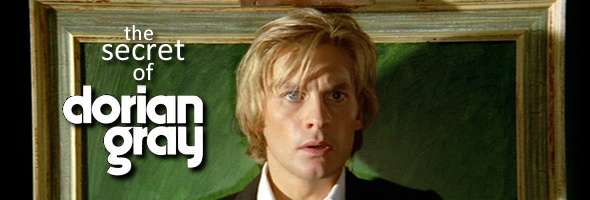
Color, 1970, 101m.
Directed by Massimo Dallamano
Starring Helmut Berger, Richard Todd, Herbert Lom, Marie Liljedahl, Margaret Lee, Maria Rohm, Beryl Cunningham, Isa Miranda, Eleonora Rossi-Drago
Raro (DVD) (US R0 NTSC)/ WS (1.66:1) (16:9), Kinowelt (Germany R2 PAL) / WS (1.55:1)
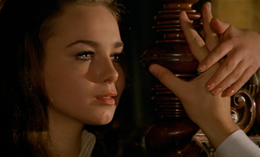 Oscar Wilde's only novel, 1890's The Picture of Dorian Gray, has always been one of the oddest books in the classic horror canon; its central macabre concept of a man remaining eternally young while his portrait ages horrifically in his attic is certainly a strong one, but much of the book is approached as a dark comedy of manners with a couple of murders and some faintly implied sexual debauchery thrown in. That leaves plenty of wiggle room for filmmakers to adapt the story however they see fit, ranging from early silent adaptations to an acclaimed and tasteful 1945 MGM version, a gender-bending made-for-TV movie, and even a comic book character in The League of Extraordinary Gentlemen.
Oscar Wilde's only novel, 1890's The Picture of Dorian Gray, has always been one of the oddest books in the classic horror canon; its central macabre concept of a man remaining eternally young while his portrait ages horrifically in his attic is certainly a strong one, but much of the book is approached as a dark comedy of manners with a couple of murders and some faintly implied sexual debauchery thrown in. That leaves plenty of wiggle room for filmmakers to adapt the story however they see fit, ranging from early silent adaptations to an acclaimed and tasteful 1945 MGM version, a gender-bending made-for-TV movie, and even a comic book character in The League of Extraordinary Gentlemen.
The word "tasteful" has definitely never been applied to the 1970 Italian-German co-production, released in America simply as Dorian Gray but more often referred to internationally as The Secret of Dorian Gray. Director Massimo Dallamano, who had just helmed the 1969 sexploitation film Devil in the Flesh and would go on to more horrific fare like The Night Child and What Have You Done to Solange?, let it all hang out here with a wild mixture of mod clothes, psychedelic music, and plentiful sex scenes, incurring the wrath of critics over its Eurotrash pedigree and "tacky" stylings. Time has been surprisingly kind to the film, turning its excesses into a flamboyantly entertaining time capsule that updates its protagonist to swinging '60s London courtesy of star Helmut Berger, a rising pretty boy star hot off his first major lead in the controversial The Damned. Regardless of how one feels about the film, there's no denying that Berger is perfectly cast here; his vaguely creepy Aryan appeal and blank slate persona make him the ideal Dorian for the sexual revolution.
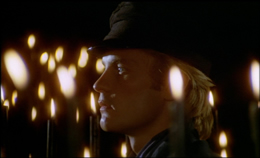 Shuffling the narrative a bit, the film opens in the '60s with Dorian murdering an offscreen victim in his attic and washing blood of his hands before sulking moodily in front of a fireplace. Through flashback we then leap back to the roaring '20s where Dorian attends a drag cabaret act with his painter friend Basil (Todd), who introduces him to the married but exceedingly amoral libertine pair of Henry Wotton (Lom) and Alice (Rohm). Dorian gives in to Basil's pleas to paint his portrait, and upon seeing its completion, Dorian verbally offers to exchange his soul for the picture to grow old instead of himself. Meanwhile he embarks on an ill-fated romance with an aspiring Shakespearean actress, Sybil Vane (softcore starlet Liljedahl), and as time passes he becomes increasingly decadent, whether getting groped by a middle-aged matron in a horse stable, cruising the local docks and bathrooms, dabbling in covert steam room trysts, or luring married woman to their doom. When someone finally figures out exactly why Dorian keeps looking so gosh darn youthful all these years, all of his demons finally rise to the surface...
Shuffling the narrative a bit, the film opens in the '60s with Dorian murdering an offscreen victim in his attic and washing blood of his hands before sulking moodily in front of a fireplace. Through flashback we then leap back to the roaring '20s where Dorian attends a drag cabaret act with his painter friend Basil (Todd), who introduces him to the married but exceedingly amoral libertine pair of Henry Wotton (Lom) and Alice (Rohm). Dorian gives in to Basil's pleas to paint his portrait, and upon seeing its completion, Dorian verbally offers to exchange his soul for the picture to grow old instead of himself. Meanwhile he embarks on an ill-fated romance with an aspiring Shakespearean actress, Sybil Vane (softcore starlet Liljedahl), and as time passes he becomes increasingly decadent, whether getting groped by a middle-aged matron in a horse stable, cruising the local docks and bathrooms, dabbling in covert steam room trysts, or luring married woman to their doom. When someone finally figures out exactly why Dorian keeps looking so gosh darn youthful all these years, all of his demons finally rise to the surface...
Anyone expecting an austere reading of the Wilde classic is going to be in for a major shock with this one. Even the early '20s scenes feel like a pop art concoction with plenty of eye-popping colors and fuzz guitars, and when the film finally slides into the "present day," the fashions run riot with Berger stealing the film in an astounding zebra-pattern coat that leaves good taste trampled in the dust. Then there's the cast, including a host of familiar faces from Jess Franco films of the period like Lom, Lee, Liljedahl, and Rohn; this would actually make a perfect double feature with Franco's Eugenie... The Story of Her Journey into Peversion, which shares two of its stars and covers fairly similar ground the same year-- and both were made courtesy of notorious producer Harry Alan Towers.
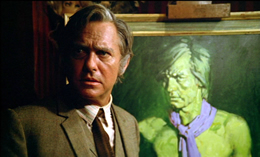 Like many of its European ilk at the time, Dorian Gray was released in a confusing variety of versions in different countries. In America it clocked in at 88 minutes courtesy of AIP and sported an R rating, often being booked as a sexploitation film in some less reputable theaters; the sexual content is extremely tame compared to the onslaught to come in the following decade, but the occasional doses of bare flesh and the hero's pansexual activities were enough to raise serious eyebrows at the time. Several hefty chunks of straight-from-Wilde dialogue and some extra bare Berger in the swimming pool were trimmed out compared to the Euro versions, while the opening credits featured different selections from Peppino De Luca's wonderful score (including the love theme for Dorian and Sybil used at least in Germany). However, the European versions also generally lost some footage compared to the American cut, including a longer nightclub scene before Dorian's seduction of Gwenodlyn and an extension of Dorian's
Like many of its European ilk at the time, Dorian Gray was released in a confusing variety of versions in different countries. In America it clocked in at 88 minutes courtesy of AIP and sported an R rating, often being booked as a sexploitation film in some less reputable theaters; the sexual content is extremely tame compared to the onslaught to come in the following decade, but the occasional doses of bare flesh and the hero's pansexual activities were enough to raise serious eyebrows at the time. Several hefty chunks of straight-from-Wilde dialogue and some extra bare Berger in the swimming pool were trimmed out compared to the Euro versions, while the opening credits featured different selections from Peppino De Luca's wonderful score (including the love theme for Dorian and Sybil used at least in Germany). However, the European versions also generally lost some footage compared to the American cut, including a longer nightclub scene before Dorian's seduction of Gwenodlyn and an extension of Dorian's 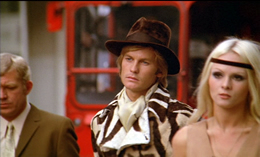 guilt-ridden trauma following his first murder.
guilt-ridden trauma following his first murder.
In America the film was released on VHS twice from Republic (in its various iterations), both times reflecting the AIP cut. The first DVD came much, much later from Kinowelt in Germany, with no English track but containing the extra snippets of Euro footage for completists. Raro's announcement of an American DVD release obviously posed the question of exactly what viewers would be getting, and surprisingly, it's the best of both worlds and then some. All of the European footage is here (Lom's extended speeches to Berger, the scene with Sybil's brother and mother, etc.), as well as the exclusive American footage; in addition you get two bonuses, an extended (but still brief) prologue before the credits and a strange, impressionistic little vignette late in the film implying Dorian's participation in a nude black mass ritual. The image quality (cited as being from the original negative) easily blows away every other version out there, including the few theatrical prints left circulating; it's in pristine condition, with exceptionally punchy colors and much more detail that allows you to savor some of the wilder touches in the sets and costumes. Hopefully Raro will consider this one for the Blu-Ray treatment soon, as it would look absolutely killer in high def. Significantly, this is also the first time the complete English language track has ever been released, and it sounds great; the Italian dub is also included (in somewhat rougher condition), and it's an interesting but inferior variant as only the English track includes Lom and Todd's original voices. (Berger was clearly speaking English as well, even though his voice was looped by another performer.) The Italian track also features optional English subtitles which are definitely not dubtitles; they instead translate that track directly and offer some surprisingly drastic differences in translation. Extras include a director filmography, an illustrated liner notes booklet, and most substantially, a half-hour video interview with assistant director Maurizio Tanfani, who covers everything from his partnership with the late Bruno Mattei to early casting considerations for the role of Dorian (Franco Nero!) and the problems involved in doing extensive make-up on Herbert Lom's nose. (Incidentally, this title was originally announced several months earlier, but the initial discs were faulty after the the layer change on the DVD; these were quickly recalled and the release date changed, so any new copies out there should be fine.)
Reviewed on July 20, 2011.


 Oscar Wilde's only novel, 1890's The Picture of Dorian Gray, has always been one of the oddest books in the classic horror canon; its central macabre concept of a man remaining eternally young while his portrait ages horrifically in his attic is certainly a strong one, but much of the book is approached as a dark comedy of manners with a couple of murders and some faintly implied sexual debauchery thrown in. That leaves plenty of wiggle room for filmmakers to adapt the story however they see fit, ranging from early silent adaptations to an acclaimed and tasteful 1945 MGM version, a gender-bending made-for-TV movie, and even a comic book character in The League of Extraordinary Gentlemen.
Oscar Wilde's only novel, 1890's The Picture of Dorian Gray, has always been one of the oddest books in the classic horror canon; its central macabre concept of a man remaining eternally young while his portrait ages horrifically in his attic is certainly a strong one, but much of the book is approached as a dark comedy of manners with a couple of murders and some faintly implied sexual debauchery thrown in. That leaves plenty of wiggle room for filmmakers to adapt the story however they see fit, ranging from early silent adaptations to an acclaimed and tasteful 1945 MGM version, a gender-bending made-for-TV movie, and even a comic book character in The League of Extraordinary Gentlemen.


